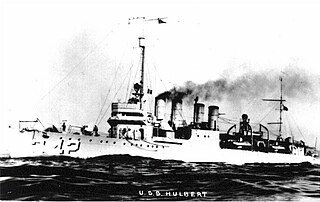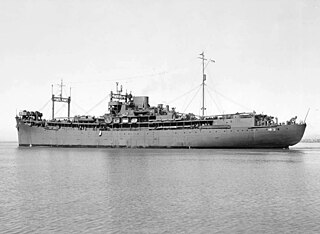
USS Monaghan (DD-354) was the last ship built of the Farragut-class destroyer design. She was named for Ensign John R. Monaghan. Monaghan was laid down on November 21, 1933 at the Boston Navy Yard, and launched on January 9, 1935. She was sponsored by Miss Mary F. Monaghan, niece of Ensign Monaghan, and commissioned on 19 April 1935. During the next few years Monaghan operated primarily in the North Atlantic, training US Navy personnel who served in World War II. Monaghan was present during the Pearl Harbor raid on December 7, 1941. She participated in the Battle of the Coral Sea and the Battle of Midway in 1942. Monaghan was sunk in Typhoon Cobra east of the Philippines in 1944.

The Mahan-class destroyers of the United States Navy were a series of 18 destroyers of which the first 16 were laid down in 1934. The last two of the 18, Dunlap and Fanning, are sometimes considered a separate ship class. All 18 were commissioned in 1936 and 1937. Mahan was the lead ship, named for Rear Admiral Alfred Thayer Mahan, an influential historian and theorist on sea power.

USS Finback (SS-230), a Gato-class submarine, was the first ship of the United States Navy to be named for the finback. Nine of Finback's twelve World War II patrols in the Pacific were designated as "successful"; she received 13 battle stars for her service and is credited with having sunk nearly 70 thousand tons of enemy shipping.

USS Aspro (SS/AGSS-309), a Balao-class submarine, was the first ship of the United States Navy to be named for the aspro, a fish found abundantly in the upper Rhône River. According to legend, the aspro comes to the surface only in bad weather, when other fishes take refuge near the bottom. This trait gave rise to its nickname, "Sorcerer."

The first USS Parche (SS-384/AGSS-384) was a United States Navy submarine. She bore the name of a butterfly fish, Chaetodon capistratus. Parche was a Balao-class submarine that operated in World War II.

USS Hulbert (DD-342/AVD-6) was a Clemson-class destroyer in the United States Navy following World War I. She was named for Henry Hulbert.

USS Sicard (DD-346/DM-21/AG-100) was a Clemson-class destroyer in the United States Navy following World War I. She was named for Montgomery Sicard.

The first USS Dewey (DD-349) was a Farragut-class destroyer of the United States Navy, launched in 1934 and named for Admiral George Dewey. Dewey served in the Pacific through World War II. After escaping damage during the Attack on Pearl Harbor, Dewey screened the aircraft carrier USS Lexington until the carrier was lost in the Battle of the Coral Sea; then screened USS Saratoga through the Invasion of Guadalcanal and the Battle of the Eastern Solomons. Following overhaul in San Francisco, Dewey spent 1943 in Alaskan waters supporting the invasions of Attu and Kiska. Dewey spent 1944 supporting raids in the Marshalls, Carolines, and Marianas, including screening carriers during the Battle of the Philippine Sea. After being damaged by Typhoon Cobra during the Recapture of the Philippines, Dewey supported the invasion of Iwo Jima and spent the remainder of the war screening replenishment oilers.

The second USS Gridley (DD-380) was the lead ship of her class of destroyers in the United States Navy. She was the second US Navy ship named for Charles Vernon Gridley. She served with distinction in the Pacific Theater during the Second World War and shared in the sinking of a Japanese submarine.

USS Case (DD-370) was a Mahan-class destroyer in the United States Navy before and during World War II. She was the second ship named for Augustus Ludlow Case. Case was berthed at Pearl Harbor when the Japanese struck on 7 December 1941, then served in the United States Pacific Fleet until the end of World War II.

USS Whitehurst (DE-634), a Buckley-class destroyer escort of the United States Navy, was named in honor of Ensign Henry Purefoy Whitehurst, Jr., a crew member of the Astoria (CA-34) who was killed during the Battle of Savo Island in August 1942.

USS Sperry (AS-12) was a Fulton-class submarine tender in the United States Navy. She was named for Elmer Sperry.
USS Oracle (AM-103) was an Auk-class minesweeper built for the United States Navy during World War II. She was commissioned in May 1943 and decommissioned in May 1946. She was placed in reserve and remained there until struck from the Naval Vessel Register in December 1966. She was sunk as a target in 1967.
USS Annoy (AM-84) was an Adroit-class minesweeper of the United States Navy. She was laid down on 3 December 1941 at Portland, Oregon, by the Commercial Iron Works; launched on 6 April 1942; and commissioned on 2 September 1942. In 1944 she was reclassified as a patrol craft and renamed PC-1588.

USS Griffin (AS-13), originally Mormacpenn, a United States Maritime Commission Type C3 pre-war cargo ship, was launched by Sun Shipbuilding & Dry Dock, Chester, Pennsylvania, 11 October 1939. She served briefly with Moore-McConnack, Inc., was acquired by the Navy in 1940, renamed Griffin (AS-13) and converted to a submarine tender at Robbins Dry Dock and Repair Company, Brooklyn, N.Y. Griffin commissioned 31 July 1941.

USS Lovering (DE-39) was an Evarts-class destroyer escort of the United States Navy during World War II. She was promptly sent off into the Pacific Ocean to protect convoys and other ships from Japanese submarines and fighter aircraft. She performed dangerous work in major battle areas and sailed home with three battle stars.

USS Koiner (DE-331) was an Edsall-class destroyer escort built for the U.S. Navy during World War II. She served in the Atlantic Ocean and the Pacific Ocean and provided destroyer escort protection against submarine and air attack for Navy vessels and convoys. Post-war, she was loaned to the U.S. Coast Guard, and also reclassified as a radar picket ship.
USS Clamp (ARS-33) was an Diver-class rescue and salvage ship acquired by the U.S. Navy during World War II. Her task was to come to the aid of stricken vessels.

USS Nemasket (AOG-10) was a Patapsco-class gasoline tanker in service with the U.S. Navy from 1944 to 1959. She was scrapped in 2006.
USS PC-1145, later USS Winnemucca (PC-1145), was a United States Navy PC-461-class submarine chaser in commission from 1944 to 1955. In 1960, she was transferred to South Korea for service in the Republic of Korea Navy.
















